This was published 8 years ago
Piedmont, Italy: The 'new Tuscany' for lovers of food and wine
By Ellen Connolly
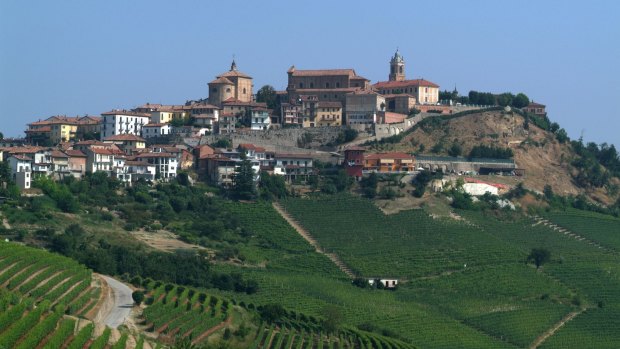
Piedmont's picturesque La Morra.Credit: Alamy
It has been described as "Tuscany without the crowds", a picturesque countryside dotted with vineyards, and a gastronomic paradise for food lovers. In Italy's north,
Piedmont is surrounded on three sides by the Alps and borders Switzerland and France. The region has successfully managed to remain under many travellers' radars, largely overlooked as a major tourist destination, but it has
world class wines, Michelin star restaurants, fairytale-like castles and stunning scenery, all of which can be enjoyed – so far – without the hordes of tourists.
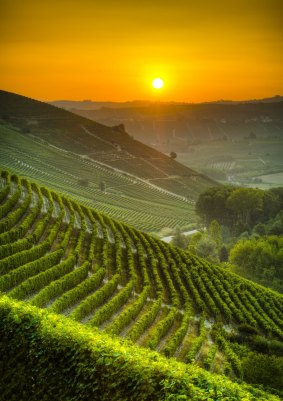
A spectacular sunset at a Piedmont vineyard.Credit: Getty Images
Piedmont (pronounced Piemonte in Italian) is, according to some locals, how Tuscany used to be. Even when we visited in November last year at the height of white truffle season, the region did not feel overrun with visitors.
As in Tuscany, fabulous wine is produced all over Piedmont, but the prime areas are the Langhe and Roero, about an hour's drive from the bustling city of Turin.
Named a UNESCO World Heritage site last year, the Langhe has vineyards that produce Italy's best-known red wines: barolo and barbaresco. Across the Tanaro River lies Roero, which is gaining a reputation for its fantastic arneis, a light floral white wine.
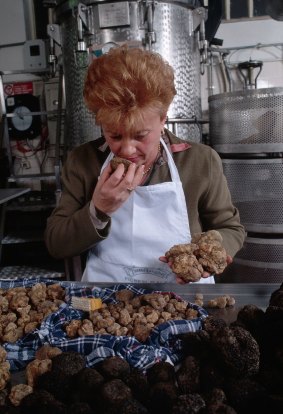
A woman smells white truffles.Credit: Alamy
To explore both areas easily, Alba is the ideal base. A charming town, it is famous for two things – white truffles which are grown, hunted and sold here, and Nutella, the indulgent hazelnut chocolate, which was invented here. The giant Ferroro factory where it is produced employs 4000 locals.
Both have helped to put Alba on the map, in particular one of the world's most expensive ingredients, white truffle, or as the Italians say "tartufo bianca".
Each year from October to the middle of November, the International Alba White Truffle Fair is held and on weekends at this time there is a giant undercover street festival where the prized tubers sit secured behind glass cases waiting to be purchased. Food and wine tastings are on offer, and people can watch cooking demonstrations.
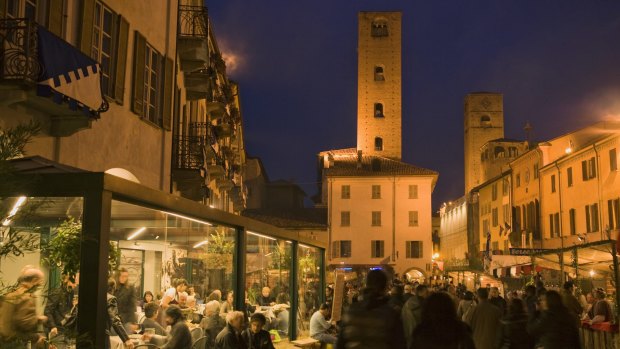
Piazza Risorgimento, Alba, Piedmont.Credit: Getty Images
Even outside tartufo season, Alba is heralded for its gastronomic delights, and meals are not only superb but great value. Our favourite spots included La Libera, a fun casual spot with an exciting menu and excellent wine list, and Osteria dell'Arco, where the pannacotta was so delicious, you should not offer to share it. Ristorante Enoclub also attracts many visitors. It has a casual restaurant upstairs and more formal dining downstairs, with plenty of truffle dishes on the menu from late October to December.
On Alba's main square, a rising young chef, Enrico Crippa, has put a contemporary spin on his menu at the 3-Michelin star Piazza Duomo, which is owned by the Ceretto winemaking family. Among the beautifully presented dishes are two deconstructed olives with minced veal and langoustine. Don't miss Salad 41, named for the 41 different greens, herbs and edible flowers.
Like most visitors to Piedmont, we spent our days driving through the hilly countryside, admiring the rolling vine-clad hills and stopping for wine tastings along the way. Unlike Tuscany, which is set up for wine tourism, Piedmont has only a handful of wineries that accept walk-ins or impromptu visits, so it is essential to be organised and book appointments.
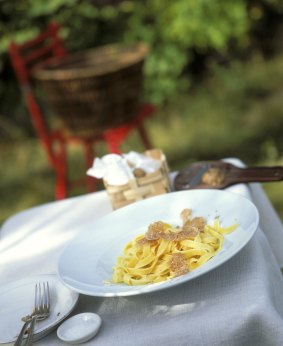
Tagliatelle alla piemontese (ribbon pasta with truffle slices).Credit: Alamy
The hottest ticket in town is Gaja winery, the world's best known producer of barola. After many decades of excluding visitors, the Gaja family began to welcome them in 2014, but it comes at a philanthropic price; Gaja requires visitors to make a $425 donation per person to support either a local charity or, if they wish, one in their home country. In return, guests enjoy a two-hour guided cellar tour and wine tasting.
Among the most tourist-friendly wineries is Ceretto Wines, which has a large drop-in visitor centre boasting magnificent views over the vine covered hills. Marchesi di Barolo also has a visitor centre as well as large areas for tastings and functions. Take a tour through the historic winery cellar.
An excellent way to experience a wide spectrum of local wines is at enoteca regionale, wine shops with tasting rooms. Owners offer tastings of five to six wines, which are available for purchase. Check out Enoteca Regionale, Barbaresco and Emilia Romagna's enoteca regionale.
In Piedmont, famed for its hearty, rich food, some regional dishes should be tried. One of the heartiest is bollito misto, meaning boiled mixed meats, which comprises seven types of meat (beef, veal, pork, chicken, calf's head, stuffed pig's trotter (zampone) and sausage (cotechino), seven vegetables and seven condiments. A common appetiser is vitello tonnato, thinly sliced veal served cold with a mayonnaise-like tuna-flavoured sauce.
Not to be missed is the local pasta speciality, tajarin or egg tagliatelle which is said to be made with 40 egg yolks per 400 grams of flour. Locals told us the best tajarin was to be found at Trattoria Antica Torre in Barbaresco, a stone's throw from Gaja's winery, and they were right. Forget about any fears of rising cholesterol and order it.
Desserts containing hazelnuts are another specialty, thanks to the numerous hazelnut orchards in the area. Much of the harvest, of course, is sent straight to the the Ferrero Rocher factory.
About ten miles west of Alba is the small, unassuming, town of Bra, a place where few tourists go but they should because it was where the Slow Food movement was founded in 1986. Take a cooking class in which the principles of slow food cooking are showcased, or enjoy a meal at a number of family-run trattorias such as Osteria Boccondivino or La Trattoria da Francesco, where traditional and regional cuisines have been preserved and honoured.
Beyond drinking and eating, there are activities such as cycling or hiking. Bikers love the challenging terrain combined with the magical scenery.
For some history, stop at the majestic 11th-century Castello di Grinzane Cavour, where you can taste wine and cheese at the on-site regional enoteca. There is also a restaurant and museum.
Shopping or gift buying is best done in Alba. Check out Tartufi Ponzio, which has an extensive range of local pasta, olive oils and vinegars, many containing, or infused with, the famed white truffle of Alba.
At Piaceri del Gusto, there is not only wine, including hard-to-find bottles, but an interesting selection of books in Italian and English about the food and wine of the region.
Accommodation is plentiful throughout Piedmont and innumerable agriturismo dot the countryside. These are similar to bed and breakfasts, and in many cases the owners offer home-cooked meals and lively conversation, sometimes pouring their small batch of personally produced wines during dinner.
For those who prefer more privacy and don't want to have to mingle with fellow guests, there are a choice of hotels.
In Alba, Hotel Calissano is a well-priced four-star establishment which has all the modern conveniences, and is in walking distance to restaurants and bars. The added bonus is that it has a gym and free parking.
The only five-star property in the Langhe is Il Boscareto Resort & Spa, located in the wine town of Serralunga d'Alba, 15km south of Alba. Perched on a hill and with tranquil views of the surrounding vineyards, it is reminder of the bounty of wonderful food, wine and scenery that exists in this much overlooked part of Italy.
FIVE MORE FOOD DESTINATIONS IN ITALY
BOLOGNA
Home to ragu and mortadella sausage, Bologna should be on every foodie's bucket list. It boasts some of the finest producers of parmigiano cheese, sausage, and balsamic vinegar in Italy. Best of all, restaurant prices are cheap. Note, you won't find bolognaise on a menu, in Italy as it is called ragu.
PUGLIA
Burrata cheese has helped put Puglia on the global food map. The creamy and luscious mozzarella originates from Puglia, but it is also Italy's second biggest wine-producing region. Set on a thin peninsula, it's great for fresh seafood, lamb, goat, cheese, and wine.
SICILY
With a long history of wine making and a thriving food scene, Sicily is an ideal summer getaway for any gourmand. Seafood dominates, thanks to its coastal location. Learn how to make arancini at a cooking school, visit a pistachio farm and eat the local dessert, cannoli.
NAPLES
Ignore those who tell you Naples is a big bustling unsafe city, and head to the birthplace of pizza. Gourmet travellers will also appreciate the smorgasbord of seafood in Naples, which is showcased in dishes such as spaghetti alle vongole and risotto alla pescatora.
FLORENCE
Beyond the art and architecture lies a lively food scene. Book a walking food tour of the city, and learn about … Tour the old food market, Mercato Centrale, and drink at cosy hole in the wall wine bars that date back more than a hundred years. Don't leave without having a Bistecca alls Florentina. (a classic Florentine T-bone steak)
TRIP NOTES
MORE INFORMATION
GETTING THERE
Alba is regarded as the gastronomic heart of Piedmont and is about 90 minutes from Turin. Alitalia has daily flights from Rome to Turin. Connect to Alba using a rental car or by train, see www.italiarail.com.
STAYING THERE
Hotel Calissano, Alba. Doubles including breakfast from $175 a night, see www.hotelcalissano.com.
SEE + DO
The Ceretto wine shop and visitor centre in Alba is open seven days a week for tastings, tours and purchases, see cretto.com. To visit the Gaja winery, email info@gaja.com. A $435/300 euro donation to a local charity is required per person.
October to December is considered the ideal time to visit as it is white truffle season. The Alba White Truffle World Fair takes place Saturdays and Sundays from the first weekend in October to early November. Entrance is $4.35, see www.fieradeltartufo.org/en.
The writer travelled with the assistance of Alba Tourist Office.
Sign up for the Traveller Deals newsletter
Get exclusive travel deals delivered straight to your inbox. Sign up now.